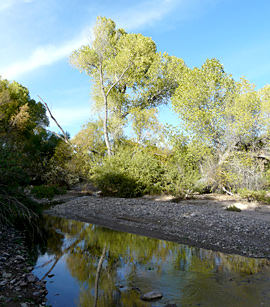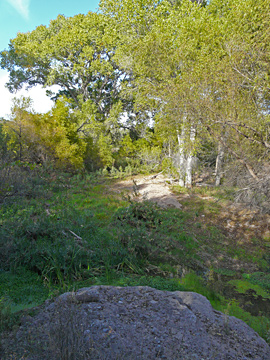As of this week, a new trail is open for guests staying at Casitas de Gila. This new trail is located on the northern end of our property and transects a 4.5 acre piece of land that we acquired in late 2010. This trail is short, only one-third mile long, yet offers an exceptionally interesting transition in natural habitat from the densely vegetated Bear Creek floodplain onto the more sparsely covered high desert vegetation of the adjacent hills.

Starting at its junction with the Big Tree Trail at the edge of Bear Creek, the Hidden Spring Traill meanders along a sand and gravel floodplain having a dominant cover of Fremont Cottonwood (Populus fremontii)*, Arizona sycamore (Platanus wrightii), and willow (Salix sp). After a short distance the trail abruptly leaves the floodplain to wind its way up a moderately sloped ridge covered with native grasses, Honey Mesquite (Prosopis glandulosa), Catclaw (aka Wait a Minute Bush) (Mimosa aculeaticarpa) and One-seed Juniper (Juniperus monosperma). At the top of the ridge the trail turns west and follows Casita Flats Road to connect with the Terrace Flat and Hillside Trail. There are excellent views of Turtle Rock and the Gila Wilderness to the east and north along the higher elevations of the trail. However, it is just where the trail leaves the floodplain that you will find the special spot from which the trail takes its name.
When walking the Hidden Spring Trail, the full effect of the abrupt change in habitat can be best experienced by starting in the floodplain at the east end of the trail.

Following the trail west from the Seep Willow (Baccarus glutinosa) lined banks of Bear Creek, you will quickly find yourself surrounded by large, old growth cottonwood and willow trees. Then, ducking under the branches of a small Arizona Alder (Alnus oblongifolia) you will abruptly leave the floodplain as you step up onto an inviting, platform-like ledge of Gila Conglomerate that juts out over a beautiful shallow pool of water.
It is here, somewhere beneath the pool at the base of this rocky ledge, I believe, that a small spring bubbles all the time, even during dry seasons. In the spirit of full naturalist disclosure, however, I must confess that I have never actually seen the spring itself! So why do I think there is a spring here? Well, when you sit on the log bench that overlooks the spring, my primary piece of evidence for this hidden spring can be seen on the far side of the pool where several clumps of the common Broad-leaved Cattail (Typha latifolia) are growing.
Cattails, of course, are the quintessential natives of perennial wetlands and marshes. Over the years, I guess I have some explored some eight miles of Bear Creek, yet this is the only place where I have ever seen cattails. So I found myself asking, Why here? While I have never been to this exact spot during an extended dry spell, what I have witnessed along this stretch of Bear Creek, particularly during La Niña years, are times when the creek has gone completely dry for a couple of months. Not exactly cattail habitat. So for me, that’s the primary evidence. There is also some suggested evidence of a geological nature, such as the presence of nearby faults and stratigraphic and hydrologic factors within the Bear Creek aquifer itself, but that will require some more looking into.
In any case, time should tell fairly soon. At present, New Mexico is experiencing a La Niña winter, which means little moisture will occur here until the monsoon rains come towards the end of June or early July. Unless we have a lot of precipitation later this winter or during the spring, which is not likely, the flow along Bear Creek will gradually shrink to its lowest point by the middle of June. If that happens, the truth should become obvious, and, after I enjoy eating a fine meal of humble pie, we may have to change the name of the trail!
Nevertheless, be there a hidden spring here or not, what I am sure of is that anyone who stops and sits for even a few minutes at this secluded place will agree that this is, indeed, a special spot.

I first came across this very spot almost 13 years ago when Becky and I were considering our purchase of land for the Casitas. I still recall quite clearly how I lingered there for quite some time that October day, slowly taking in the natural beauty and various feelings that I was sensing while observing the little pool, and the numerous birds that were flying in and out of the canopy of ancient cottonwoods that soared high over the floodplain beyond. But that bit of land with the spring was not to become ours until late 2010.
Now I am able to return to this spot quite often to sit quietly and observe. And each time the experience is as refreshing as before. For when the wind is softly rustling the leaves of the magnificent cottonwoods overhead, and the birds and butterflies are flitting through their branches to the soft murmur of Bear Creek gurgling nearby, to me, this small spot is truly magical.
May you find it the same!
Click here to download a copy of the Casitas Trail Map in .pdf format.
*Reference:
For those who have further interest in the plants of the Gila Wilderness area, or who would like to see great photographs of the plants mentioned in this blog, an excellent on-line source is Vascular Plants of the Gila Wilderness by Dr. Russ Kleinman, Associate Botanist, Dale A. Zimmerman Herbarium, Western New Mexico University Department of Natural Sciences: http://www.wnmu.edu/academic/nspages/gilaflora/index.html


